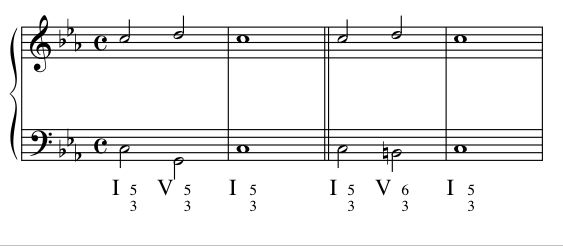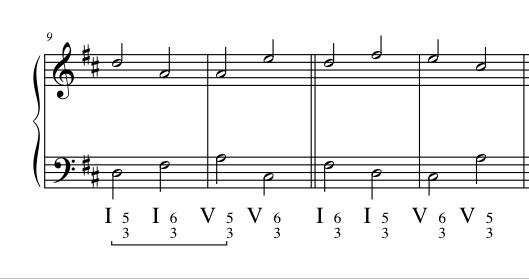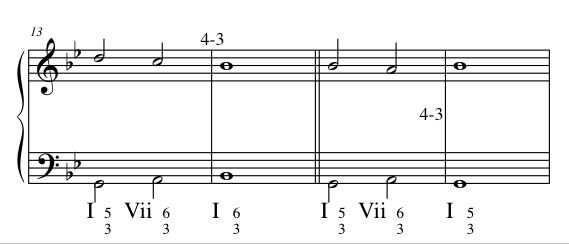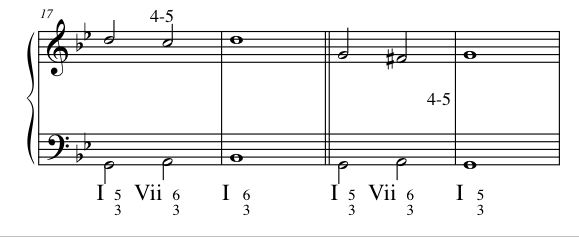Homework: Workbook Chapter 7 pg 47-8#1(a,b,c,i,j,k) pg 49 (a,b,c,h,i) pg 50 (1,2,3,5,7)
I6 and V6
1. New Possibilities for the Bass
a. By using the 6-3 position of the I & V chords, we enrich the harmonic capacity of the progression without losing the critical relationship between the tonic and dominant structures. As well, since the bass line can now fall on the 1st and 3rd scale degress for the I chord and the 5th and 7th scale degrees for the V chord, the bass line begins to take on a melodic character of its own.
2. 16 and V6 Expanding I and V (see example 6-1)
a. A very frequent way of expanding the I and V chord is by using them in 6-3 position. It is very important that you develop the ability to hear the difference in the positions
In Class: Listen carefully to the difference between the 5-3 and 6-3 Then fill in the T&A following the rules of 4 part writing.


3. 6-3 expanding 5-3
a. Look at H&VL Ex. 7-4 to see common expansions between 5-3 and 6-3. Of particular interest are parallel 10ths between the bass and soprano and contrary voice exchange between the bass and soprano.
4. Doubling 16 and V6
a. Since the bass tone of the 16 contains the 3rd scale degree (thereby defining the modal nature of the chord) you may double any of the upper voices without losing the chords identity. The V6 CONTAINS THE LEADING TONE IN THE BASS and thus the bass may not be doubled.
5. 6-3 substituting for 5-3
a. When you dont need the stability of the 1st scale degree, you may substitute I6 for I
b. Keep in mind that the interval of a 6th is a less stable conssonance than that of a 5th and thus the 6-3 will tend to be more active by nature. When you need an absolute finality, 5-3 is the better choice.
6. I-I6-V Arpeggiation in the Bass
a. When the bass moves from the 1st scale degree to the 3rd scale degree under a constant or stable T-A-S harmony, a bass arpeggiation results in a 16 figure.
7. V6 within the expanded tonic
a. V6 creates a stepwise 8-7-8 Bass line. Since the bass of the V6 is the leading tone, it almost always resolves back to 1. (remember, there is that exceptional case where the leading tone exists above a bass tone as a consonant. In these cases, the leading tone may actually move down to the 5th scale degree and not up to the 1st scale degree. This however, is almost always in an upper voice)
b. Like the 16, but perhaps more so, the V6 is much more active. When a finality or great sense of stability is needed, it is better to use the 5-3 position.
8. 5-3 Expanding 6-3
a. Occassionally, rhythmic and melodic factors will make 5-3 subordinate to 6-3. In these cases 5-3 may be used to expand a 6-3
In Class: Listen carefully to the expansion to 6-3 both from and to 5-3 then fill in T&A

Vii6
(Leading Tone Triad)
9. 2 in the bass
a. We have seen with the V6 chord that the bass line forms a melodic neighbor tone when surrounded by I5 chords. Similarly, the Vii6 chords contains the 2nd scale degree in the bass and can therefore serve as a melodic bass that passes between I5 to I6 or as a neighbor tone to either I5 or I6. Since the Dominant scale degree is missing from the Vii chord, it tends to be less stable and thus, it often serves as a "passing", melodic and contrapuntal chord. As well the insertion of a Vii chord (or V chord) can be very useful in breaking unwanted parallel motion (see ex. 7-12+13)
10. Doublings in the Vii6
a. Very typically the 2nd scale degree is doubled. Occassionally the 4th scale degree is doubled (see below) Never double the 7th (leading tone) scale degree.
11. Resolution of the Tritone
a. The Vii chord contains the 2nd scale degree as its root. The upper tones fall on the 4th and 7th scale degrees and therefore create a tritone of either a A4 or d5. Typically the dissonance of this tritone resolves with the 4th scale degree falling to the 3rd and the 7th scale degree rising to the 8th However, when the dissonance appears as an A4th, the effect of similar motion from an A4th in the the Vii6 to P4th in the I is softened. This is particularly true when the 2nd scale degree of the bass Vii6 moves to the 3rd scale degree of the I chord as it provides the critical third of the I chord which is now absent due to the upward resolution of the 4th scale degree Similarly, if the bass rises to assume the critical 3rd scale degree of the I chord, the d5th may be resolved with similar motion to a P5th. (Remember, in 1st species counterpoint, similar motion from P5 to d5 is allowed but similar motion from a d5 to a P5 is forbidden. (see 7-14+15+16)
b. When the 4th scale degree of the Vii chord is doubled, the chord may contain both an A4 and d5. In such a case, resolve the d5th normally and let the A4 resolve in similar motion to a P4
Summary: When Vii6 moves to I6, it is not necessary for the tritone to resolve normally. The 4th Scale degree may move up to 5. If Vii6 moves to I5, the d5 must resolve normally. If Vii6 moves to I5 the A4 may move to a P4 especially when the 2nd scale degree bass is doubled and the doubling moves to the 3rd scale degree. Avoid using a root position Vii5 chord for now.
Note: These kinds of exceptions are critical to understand as the rules of harmony are always subservient to the function of that harmony. You should always keep this in mind
In Class: Fill in the Following Choral settings making sure you resolve the 4th scale degree as indicated.


|

